

- PHOTOS:
- Dec 16, 2008 - May 21, 2009
- Mar 17, 2008 - Dec 15, 2008
- Nov 01, 2007 - Mar 16, 2008
- Our SC35 Sailboat: PRUDENCE
- SELECTED BLOGS
- Jan'05: The Idea
- May'05: First Cruise - Belize
- Aug'05: Buying Ashiya
- Oct'05: School in St. Vincent
- Nov'05: Ocracoke on Ashiya
- Jul'06: Long Trip on Ashiya
- Oct'06: Prudence Comes Home
- Nov'07: First Night Offshore
- Nov'07: Offshore Take Two
- Nov'07: Gulf Stream Crossing
- Dec'07: Green Turtle Cay
- Dec'07: Lynyard Cay
- Dec'07: Warderick Wells Cay
- Jan'08: George Town
- Jan'08: Life without a Fridge
- Jan'08: Mayaguana Island
- Jan'08: Turks & Caicos
- Jan'08: Dominican Republic
- Jan'08: Down the Waterfalls
- Feb'08: Puerto Rico
- Feb'08: Starter Troubles
- Feb'08: Vieques
- Mar'08: Finally Sailing Again
- Mar'08: Trip So Far
- Mar'08: Hiking Culebra
- Mar'08: Kayak & Snorkel I
- Mar'08: Teak and Waterspouts
- Mar'08: Kayak & Snorkel II
- Mar'08: Bottom Cleaning
- Apr'08: Culebra Social Life
- Apr'08: Culebra Routine
- Apr'08: Culebra Beaches
- Apr'08: Culebrita
- Jun'08: Kayak & Snorkel III
- Jun'08: Kayak & Snorkel IV
- Jun'08: Manta Ray
- Jun'08: Sea Turtles
- Jul'08: Cost of Cruising
- Jul'08: Busy Week in Culebra
- Jul'08: Getting to Land
- Jul'08: Leatherback Boil
- Jul'08: Fish and Volcano Dust
- Aug'08: Teaching Algebra
- Sep'08: Culebra Card Club
- Oct'08: Kayak & Snorkel V
- Oct'08: Prep for Hurricane
- Oct'08: Hurricane Omar
- Oct'08: Fish and Sea Glass
- Oct'08: Waterspouts
- Dec'08: Hurricane Season Ends
- Dec'08: Culebra to St. Martin
- Jan'09: Antigua Part 1
- Feb'09: The Saints
- Feb'09: Visiting Dominica
- Mar'09: Antigua Part 2
- Apr'09: Antigua to Bermuda
- May'09: Bermuda to Norfolk
- FULL LIST of Blog Entries
15 July 2009
14 July 2009
15 June 2009
14 June 2009 | Annapolis, MD
13 June 2009
12 June 2009
11 June 2009
10 June 2009 | Little Creek Marina, Norfolk, VA, USA
04 June 2009 | Little Creek Marina, Norfolk, VA, USA
31 May 2009 | Little Creek Marina, Norfolk, VA, USA
29 May 2009 | Little Creek Marina, Norfolk, VA, USA
26 May 2009 | Little Creek Marina, Norfolk, VA, USA
25 May 2009 | Little Creek Marina, Norfolk, VA, USA
13 May 2009 | through 21-May-2009
13 May 2009 | through 21-May-2009
12 May 2009 | St George's Town, Bermuda
11 May 2009 | St George's Town, Bermuda
07 May 2009 | St George's Town, Bermuda
04 May 2009 | St George's Town, Bermuda
21 April 2009 | through 02-May-2009
Wind and Waves Amount to a Wet Ride: The Passage to Dominica
25 February 2009 | Portsmouth, Dominica

CURRENT LOCATION: Anchored in Prince Rupert Bay, off the town of Portsmouth, Dominica
15 34.671' N, 061 27.622' W
We spent two nights anchored in Anse Fideling, The Saints. It is nice to have time to gather all of your ducks and put them in a row prior to making a crossing. On Tuesday, I was able to deflate and bake our kayaks in the sun so that they would be dry when folded up and stuffed back into their storage bags. I also took advantage of our relatively calm motion to top off the fuel tank from our jerry cans. I feel that it is important to keep the fuel tank as full as possible for two reasons: One, there is less room for motion of liquid within the tank (or schloshing) and, consequently, less opportunity for the black crud at the bottom to get stirred up and clog our fuel filters. Second, less air in the tank means less opportunity for moisture to condense, providing an environment for bacterial growth and eventual accumulation of more black crud. All of our fuel passes through a water-separating filter as it is poured from the jerry cans into the tank. It is our hope that it will continue to remain water-free once aboard. For the record, we have burned approximately 15 gallons of diesel fuel since departing from Culebra in December.
Sheryl took the opportunity of this beautiful sunny day to do a little snorkeling over by the rock cliffs where the crazy divers were in action the day before. She was able to get a few more underwater photos to complete her 'Guadeloupe 2009' Flickr collection. The star of today's show was a baby-sized porcupine fish:
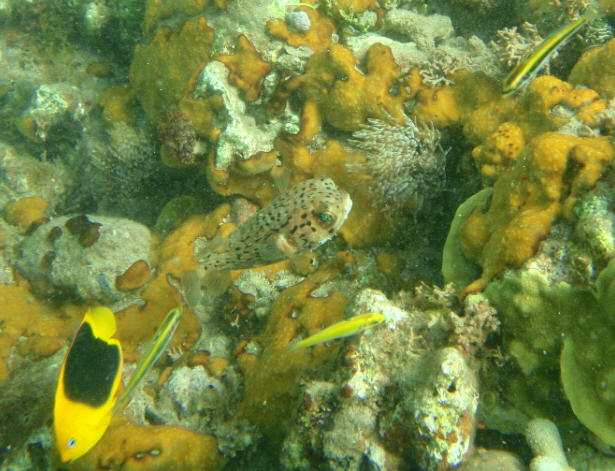
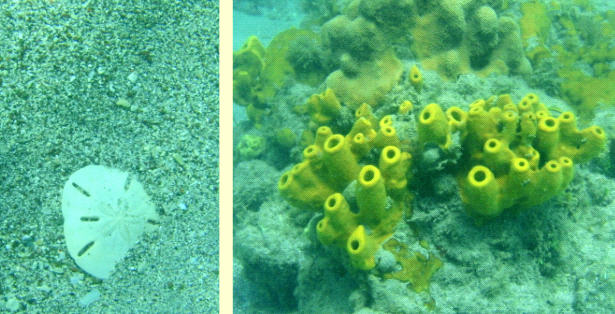
Bright and early on Wednesday morning we picked up both of our anchors and were off, bound for Dominica. We motored only a short distance before finding plenty of wind upon which to sail. Too much wind, in fact. We were on a close reach with winds ranging between 20 and 30 knots (most frequently steady at the mid-range between those two numbers). The seas were huge, as well. This was not at all the conditions forecasted for today. In fact, we have not seen conditions like this since we crossed from the Turks & Caicos to the Dominican Republic last year (another occasion where the forecasters got it completely wrong). On a positive note, the seas had a reasonably long period (unlike our recent crossing of the Canal des Saints, where the waves were way too close together and resulted in washing machine-like ride). We adjusted our sails for the current conditions: single reef in the main, full staysail, and partially furled genoa; and soldiered onward toward Dominica.
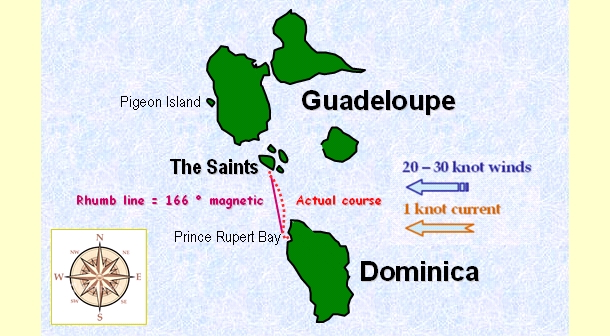
Overall, the sailing conditions were not too bad. It is amazing how much difference a few more degrees off the wind makes. Sailing on a close reach is an entirely different world from sailing close hauled. Our speeds on a close reach are much greater, 5 knots as compared to 3 knots. This greater speed through the water diminishes the west-setting effects of the wind and the current (the longer we are exposed to those forces, the further away from our desired course we drift). The extra velocity also gives us the power to push through the waves. At slower speeds, the waves knock us back stealing our miniscule momentum. Bouncing boisterously through these rather ominous seas today was actually, almost fun. We even managed to make a little better than our rhumb line (further east) for the first few hours of the crossing and eventually had to fall off to make our Dominica waypoint.
Generally speaking, Prudence is a 'dry' boat. Water does not accumulate in the bilge, there are no leaks when it rains (knock wood), and we rarely take seawater on deck when underway. Sure, with any sort of rough conditions, we get a fine salt spray which coats the decks, the rigging, and our sunglasses, but rarely what we have heard others refer to as, "... an avalanche of green water rushing across our foredeck." I think that this is largely due to the shape of our hull and the way it cleaves through the water and pushes the bulk of the heavy liquid out to the side when we are smashing through waves:
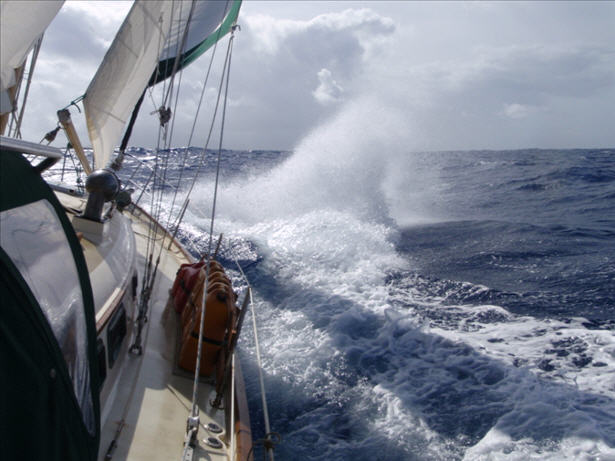
Any water which does end up accumulating on deck quickly rushes toward our quarter and is shed without causing us any concern:
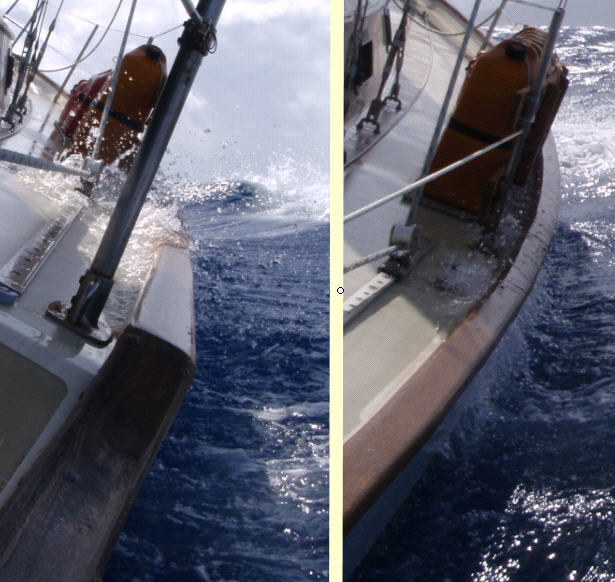
Today's crossing conditions did, however, introduce a new factor to the wetness equation. The wind direction and magnitude occasionally caused the large plume of water which was cast out on our windward side to be scattered by the wind and tossed back into our face. This only happened a half-dozen times during our 4-hour crossing, but it was the first experience we have ever had of getting repeatedly soaked with seawater while underway.
It happens quickly and without warning. One minute all is clear ...
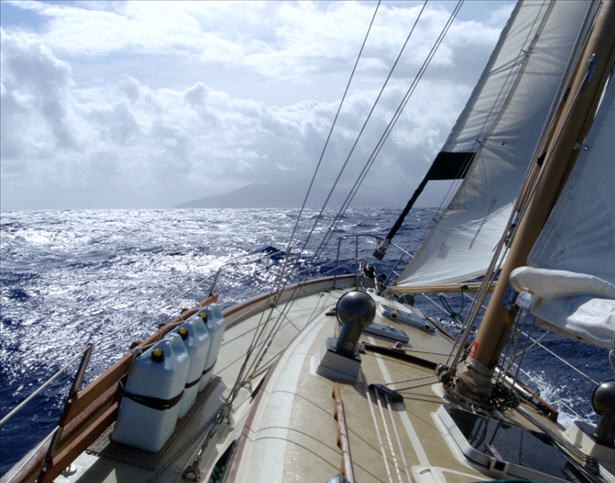
... and the next, the sky is alive with thousands of water globules ... headed our way:
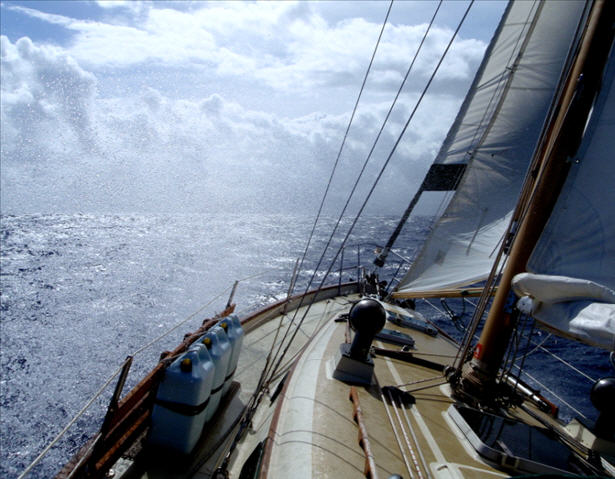
Let's take a closer look at this photo Sheryl just happened to snap seconds before she, I, and the camera were dripping with salt water:
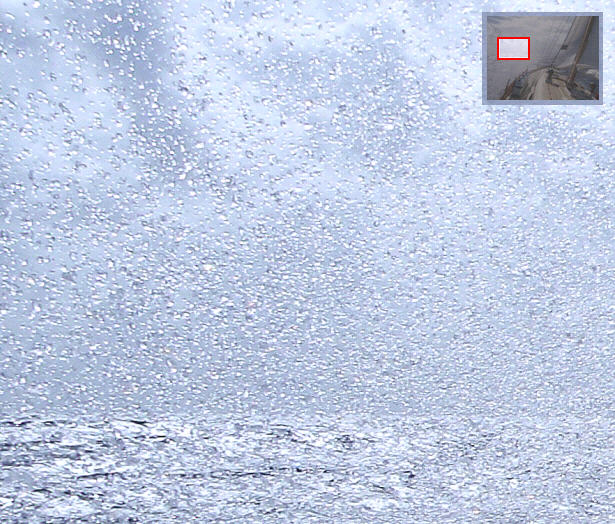
Of course, I am not complaining. Here in the tropics, a quick shower is generally refreshing (I certainly have no desire to experience higher-latitude, cold-weather, cold-water sailing). Although, even in this warm climate freshwater is generally the preferred medium for a shower. These occasional salt-water soakings, followed by an aggressive wind-blown drying, leave one feeling crusty and looking just a little bit scary:

So, since my countenance was obviously unsuitable for public display, Sheryl took care of getting us cleared into the country of Dominica on her own. We anchored in Prince Rupert Bay near the town of Portsmouth. Here, some locals have formed the Indian River Guides Association to assist the boaters and provide tours. Their colorful boats are seen frequently zipping though the anchorage and go by names such as Cobra, Sea Bird, and Providence. They offer water taxi services, and (rather than take an hour to inflate and assemble the dinghy) Sheryl simply called for a ride.
A bright yellow boat with Alexis painted on the side greeted us as we rounded the corner into the bay, and he will serve as our 'go-to' guy for anything we need during our stay. Sheryl obtained the standard clearance for a two-week stay in Dominica with no problems. In fact, the officials here were amazed that we were able to obtain customs & immigration clearance from The Saints. Obviously, other cruisers have not been as persistent nor as lucky as Captain Sheryl.
After covering 22 rambunctious nautical miles, we sit here with our anchor firmly set and the Dominica courtesy flag flying above our heads. We plan to approach our explorations of this island at a leisurely pace. Stay tuned for details from this eco tourist-oriented destination. The newly created Flickr collection, 'Dominica 2009' is bound to be a good one.


15 34.671' N, 061 27.622' W
We spent two nights anchored in Anse Fideling, The Saints. It is nice to have time to gather all of your ducks and put them in a row prior to making a crossing. On Tuesday, I was able to deflate and bake our kayaks in the sun so that they would be dry when folded up and stuffed back into their storage bags. I also took advantage of our relatively calm motion to top off the fuel tank from our jerry cans. I feel that it is important to keep the fuel tank as full as possible for two reasons: One, there is less room for motion of liquid within the tank (or schloshing) and, consequently, less opportunity for the black crud at the bottom to get stirred up and clog our fuel filters. Second, less air in the tank means less opportunity for moisture to condense, providing an environment for bacterial growth and eventual accumulation of more black crud. All of our fuel passes through a water-separating filter as it is poured from the jerry cans into the tank. It is our hope that it will continue to remain water-free once aboard. For the record, we have burned approximately 15 gallons of diesel fuel since departing from Culebra in December.
Sheryl took the opportunity of this beautiful sunny day to do a little snorkeling over by the rock cliffs where the crazy divers were in action the day before. She was able to get a few more underwater photos to complete her 'Guadeloupe 2009' Flickr collection. The star of today's show was a baby-sized porcupine fish:


Bright and early on Wednesday morning we picked up both of our anchors and were off, bound for Dominica. We motored only a short distance before finding plenty of wind upon which to sail. Too much wind, in fact. We were on a close reach with winds ranging between 20 and 30 knots (most frequently steady at the mid-range between those two numbers). The seas were huge, as well. This was not at all the conditions forecasted for today. In fact, we have not seen conditions like this since we crossed from the Turks & Caicos to the Dominican Republic last year (another occasion where the forecasters got it completely wrong). On a positive note, the seas had a reasonably long period (unlike our recent crossing of the Canal des Saints, where the waves were way too close together and resulted in washing machine-like ride). We adjusted our sails for the current conditions: single reef in the main, full staysail, and partially furled genoa; and soldiered onward toward Dominica.

Overall, the sailing conditions were not too bad. It is amazing how much difference a few more degrees off the wind makes. Sailing on a close reach is an entirely different world from sailing close hauled. Our speeds on a close reach are much greater, 5 knots as compared to 3 knots. This greater speed through the water diminishes the west-setting effects of the wind and the current (the longer we are exposed to those forces, the further away from our desired course we drift). The extra velocity also gives us the power to push through the waves. At slower speeds, the waves knock us back stealing our miniscule momentum. Bouncing boisterously through these rather ominous seas today was actually, almost fun. We even managed to make a little better than our rhumb line (further east) for the first few hours of the crossing and eventually had to fall off to make our Dominica waypoint.
Generally speaking, Prudence is a 'dry' boat. Water does not accumulate in the bilge, there are no leaks when it rains (knock wood), and we rarely take seawater on deck when underway. Sure, with any sort of rough conditions, we get a fine salt spray which coats the decks, the rigging, and our sunglasses, but rarely what we have heard others refer to as, "... an avalanche of green water rushing across our foredeck." I think that this is largely due to the shape of our hull and the way it cleaves through the water and pushes the bulk of the heavy liquid out to the side when we are smashing through waves:

Any water which does end up accumulating on deck quickly rushes toward our quarter and is shed without causing us any concern:

Today's crossing conditions did, however, introduce a new factor to the wetness equation. The wind direction and magnitude occasionally caused the large plume of water which was cast out on our windward side to be scattered by the wind and tossed back into our face. This only happened a half-dozen times during our 4-hour crossing, but it was the first experience we have ever had of getting repeatedly soaked with seawater while underway.
It happens quickly and without warning. One minute all is clear ...

... and the next, the sky is alive with thousands of water globules ... headed our way:

Let's take a closer look at this photo Sheryl just happened to snap seconds before she, I, and the camera were dripping with salt water:

Of course, I am not complaining. Here in the tropics, a quick shower is generally refreshing (I certainly have no desire to experience higher-latitude, cold-weather, cold-water sailing). Although, even in this warm climate freshwater is generally the preferred medium for a shower. These occasional salt-water soakings, followed by an aggressive wind-blown drying, leave one feeling crusty and looking just a little bit scary:

So, since my countenance was obviously unsuitable for public display, Sheryl took care of getting us cleared into the country of Dominica on her own. We anchored in Prince Rupert Bay near the town of Portsmouth. Here, some locals have formed the Indian River Guides Association to assist the boaters and provide tours. Their colorful boats are seen frequently zipping though the anchorage and go by names such as Cobra, Sea Bird, and Providence. They offer water taxi services, and (rather than take an hour to inflate and assemble the dinghy) Sheryl simply called for a ride.
A bright yellow boat with Alexis painted on the side greeted us as we rounded the corner into the bay, and he will serve as our 'go-to' guy for anything we need during our stay. Sheryl obtained the standard clearance for a two-week stay in Dominica with no problems. In fact, the officials here were amazed that we were able to obtain customs & immigration clearance from The Saints. Obviously, other cruisers have not been as persistent nor as lucky as Captain Sheryl.
After covering 22 rambunctious nautical miles, we sit here with our anchor firmly set and the Dominica courtesy flag flying above our heads. We plan to approach our explorations of this island at a leisurely pace. Stay tuned for details from this eco tourist-oriented destination. The newly created Flickr collection, 'Dominica 2009' is bound to be a good one.

| Vessel Name: | Prudence |
| About: |
Gallery not available

- PHOTOS:
- Dec 16, 2008 - May 21, 2009
- Mar 17, 2008 - Dec 15, 2008
- Nov 01, 2007 - Mar 16, 2008
- Our SC35 Sailboat: PRUDENCE
- SELECTED BLOGS
- Jan'05: The Idea
- May'05: First Cruise - Belize
- Aug'05: Buying Ashiya
- Oct'05: School in St. Vincent
- Nov'05: Ocracoke on Ashiya
- Jul'06: Long Trip on Ashiya
- Oct'06: Prudence Comes Home
- Nov'07: First Night Offshore
- Nov'07: Offshore Take Two
- Nov'07: Gulf Stream Crossing
- Dec'07: Green Turtle Cay
- Dec'07: Lynyard Cay
- Dec'07: Warderick Wells Cay
- Jan'08: George Town
- Jan'08: Life without a Fridge
- Jan'08: Mayaguana Island
- Jan'08: Turks & Caicos
- Jan'08: Dominican Republic
- Jan'08: Down the Waterfalls
- Feb'08: Puerto Rico
- Feb'08: Starter Troubles
- Feb'08: Vieques
- Mar'08: Finally Sailing Again
- Mar'08: Trip So Far
- Mar'08: Hiking Culebra
- Mar'08: Kayak & Snorkel I
- Mar'08: Teak and Waterspouts
- Mar'08: Kayak & Snorkel II
- Mar'08: Bottom Cleaning
- Apr'08: Culebra Social Life
- Apr'08: Culebra Routine
- Apr'08: Culebra Beaches
- Apr'08: Culebrita
- Jun'08: Kayak & Snorkel III
- Jun'08: Kayak & Snorkel IV
- Jun'08: Manta Ray
- Jun'08: Sea Turtles
- Jul'08: Cost of Cruising
- Jul'08: Busy Week in Culebra
- Jul'08: Getting to Land
- Jul'08: Leatherback Boil
- Jul'08: Fish and Volcano Dust
- Aug'08: Teaching Algebra
- Sep'08: Culebra Card Club
- Oct'08: Kayak & Snorkel V
- Oct'08: Prep for Hurricane
- Oct'08: Hurricane Omar
- Oct'08: Fish and Sea Glass
- Oct'08: Waterspouts
- Dec'08: Hurricane Season Ends
- Dec'08: Culebra to St. Martin
- Jan'09: Antigua Part 1
- Feb'09: The Saints
- Feb'09: Visiting Dominica
- Mar'09: Antigua Part 2
- Apr'09: Antigua to Bermuda
- May'09: Bermuda to Norfolk
- FULL LIST of Blog Entries





